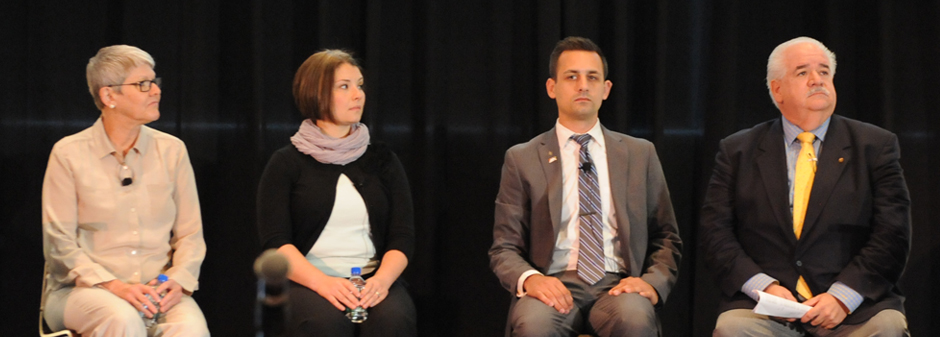NCARB 2014 Annual Report
Licensure Task Force:
Exploring Additional Pathways
The Council began exploring potential new pathways to architectural licensure through the work of its new Licensure Task Force, which kicked off in September 2013. As announced by NCARB President Blakely C. Dunn, AIA, NCARB, at the Council’s June 2013 Annual Meeting, “The task force will have some of the best and brightest thinkers, from within and outside the Council, considering how the three components of the path to licensure—education, experience, and examination—might be better integrated in that path.”
The group, which is expected do three years of research and development, is charged with:
● Developing a proposal that includes a master plan for the design and adoption of a “licensure at graduation” model and presenting the plan to the NCARB Board of Directors.
● Identifying Member Boards that are willing to participate in the process and pairing them with universities within their jurisdiction to ensure early success.
● Developing and distributing a Request for Information & Interest, and later a Request for Proposal, to NAAB-accredited programs interested in participating in a pilot program.
● Further evaluating the role employers have in the licensure process and how that responsibility can be incorporated into the program.
Diverse perspectives
Led by NCARB Immediate Past President Ronald B. Blitch, FAIA, FACHA, NCARB, the NCARB Licensure Task Force is one of several strategic initiatives underway that are positioning the Council to stay at the forefront of an evolving profession.
“We’ve assembled a blue-ribbon panel of representatives from the four architectural collateral organizations, educators, recently licensed architects/interns, and our Member Boards, to convene what I think are going to be very exciting meetings, with a potential goal that could be a milestone in the licensure of architects,” said Blitch. “The Licensure Task Force is going to involve so much trust, and so much confidence in each other’s abilities to make this work—because everybody has to be at the table to make this work—and that’s part of what makes this so exciting.”
The group is analyzing each component of the licensure process as a basis for exploring potential additional pathways that lead to licensure, including determining where there may be overlap and opportunities for efficiencies to be realized. “Part of our goal is to see if there are alternatives to speed up the current average process,” said Blitch.
The task force includes representatives from:
● American Institute of Architects
● Association of Collegiate Schools of Architecture
● American Institute of Architecture Students
● National Architectural Accrediting Board
● NCARB’s Member Boards
In November, the task force members released a statement outlining options the group was investigating and committed itself to “delivering a model(s) that reduces redundancy and creates a more efficient path to licensure.” [Read full statement]
NCARB Board of Directors endorses concept
In May 2014, the NCARB Board of Directors endorsed the concept of “licensure at graduation” as an additional, structured path to licensure. Any such pathway would be optional and integrate the rigorous internship and examination requirements that aspiring architects must fulfill into the years spent completing a professional degree in architecture.
“This additional path to licensure is another concrete step to reimagining and reconfiguring each part of the process while upholding the rigorous standards needed to protect the public’s health, safety and welfare,” NCARB CEO Mike Armstrong said.
In FY15, the Licensure Task Force will start to identify schools interested in participating in the program. NCARB expects to issue schools Requests for Information in later 2014, followed by a Request for Proposal process in 2015.
Broadly Experienced Research Team
After several months of research, the Council unveiled proposals for discussion to overhaul the Broadly Experienced Architect (BEA) and Broadly Experienced Foreign Architect (BEFA) Programs. The proposals would maintain appropriate rigor in the programs while significantly reducing completion time. These changes will optimize the process for U.S. and foreign architects who do not currently meet the requirements to earn NCARB certification for reciprocal licensure.
“NCARB maintains a goal of keeping its programs objective, attainable, defensible, and sustainable. And we’ve sought new ways to reduce the burden and cost of both programs since they’ve been heavily subsidized by the Council and cumbersome for applicants to complete,” said Armstrong. “The Board of Directors considered more than 30 options for optimizing or overhauling the programs before putting forward these proposals.”
BEA Program Proposal
Currently, the BEA process allows architects without a degree from a National Architectural Accrediting Board (NAAB) accredited program to earn the NCARB Certificate. They must:
● Have six to 10 years of licensed practice in responsible control
● Have their education evaluated by the NAAB to define education deficiencies
● Prepare a dossier to demonstrate post licensure—how they learned through experience to overcome identified education deficiencies—which is then reviewed by NCARB’s BEA Committee
The new proposal acknowledges that architects without an accredited degree are required by their original licensing jurisdiction to complete more rigorous experience requirements prior to initial licensure. It requires an applicant to complete a state board’s education and experience requirements, pass the Architect Registration Examination® (ARE®), and practice for one year. The streamlining of the submittal process also ensures an objective rather than subjective review.
BEFA Program Proposal
The BEFA process is in place for architects with a foreign license seeking NCARB certification to facilitate U.S. licensure. It currently requires:
● Establishment of an NCARB Record
● At least seven years of licensed practice in the foreign country
● Preparation of a dossier to demonstrate experience in the areas tested in the ARE
● An in-person interview
The proposal for consideration would remove most of these steps and instead would require an applicant to establish an NCARB Record, successfully complete the ARE, and document two years of experience either in the applicant’s home country or in the United States after licensure, as well as have recognized education and licensing credentials. These changes preserve some of the threshold requirements currently in place, while acknowledging work experience in the United States and requiring passage of the ARE. The addition of the ARE requirement provides assurance as to familiarity with U.S. codes and facility with the English language.
What’s Next
The proposals were distributed to NCARB’s 54 member jurisdictions for a special comment period. Member Board, collateral organizations, and stakeholder feedback will be used to inform discussions by the Board of Directors in September and December 2014. Depending on the feedback, the Board may move the proposals forward for a vote by the state boards at the next Annual Business Meeting in June 2015.
NCARB Blog: A New Social Hub

In February, the Council launched the NCARB Blog, a social hub where emerging professionals, educators, and practitioners can come together to explore industry trends. In addition to updates about NCARB programs and initiatives, the blog features guest posts from industry experts and emerging professionals.
Since launch, we’ve had over 16,000 readers with our most popular posts being related to hot topics in the profession, insight into the ARE, and suggestions on who to follow for advice on navigating the licensure process.
Top blog posts in FY14:
● What you need to know about “licensure at graduation” (June 2014)
The NCARB Board of Directors’ endorsement of the licensure at graduation concept set off a lot of discussion around the profession. We took advantage of the blog to clear up some misconceptions and answer some FAQs.
● What’s in a name? The great intern debate (March 2014)
Our very first guest post not only became one of the most popular posts of the year, but also received the most comments—both on our blog and our social media pages. Other guest posts included tips for taking the ARE, how to find an IDP friendly firm, and perspectives on navigating the IDP.
● How the ARE is scored (April 2014)
In order to provide readers with more insight on the examination, we launched a “demystifying” series explaining how the exam is developed. Topics included how the ARE is scored, who develops the exam, how items are written, and why we need to update the exam.
● New bill could alleviate student loan debt for architecture grads (March 2014)
In March, the American Institute of Architects (AIA) announced their support for proposed legislation that would alleviate student loan debt for architecture students.
● Best blogs for architecture students and interns (April 2014)
There is a lot a great advice out there for interns going through the licensure process. We featured some of the best blogs, along with great Twitter accounts and job websites.
Getting it Done! Campaign

In April 2014, we launched the “Getting it Done!” campaign to highlight the tips and tools interns can take advantage of to shorten their time to licensure. The campaign included a microsite that listed 11 ways to personalize and streamline the path to licensure. Some of the suggestions were recent tools like the IDP mobile app, others were reminders of opportunities that have been available for several years and weren’t being taken advantage of, such as concurrent testing and IDP supplemental experience options.
The campaign included a weekly tip on our social media pages, a monthly newsletter, webinars, and posts on the newly launched NCARB Blog.
One of NCARB’s main strategic goals is to facilitate licensure—both for those seeking an initial license and those seeking an additional license in another jurisdiction. To do this, we administer programs to satisfy jurisdictional requirements related to experience and examination for those working toward licensure and offer the NCARB Certificate for architects seeking licensure in other jurisdictions.
In FY14, we convened a task force to investigate ways to further integrate education, experience, and examination requirements; promoted ways for interns to streamline their path; and proposed options to overall alternative paths to NCARB certification.
Licensure and Reciprocity
OFFICER REPORTS
COMMITTEE REPORTS
FACILITATE LICENSURE
FOSTER COLLABORATION
CENTRALIZE CREDENTIAL DATA
© National Council of Architectural Registration Boards
1801 K Street NW Suite 700K
Washington, DC, 20006




